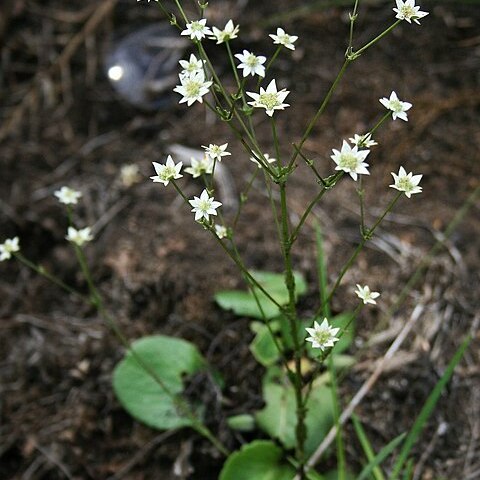Acaulescent, evergreen geophytes; aromatic and resinous throughout; solitary or gregarious, forming small groups. Rhizomes small, 5-10 mm in diameter. Roots thin, 1-2 mm in diameter, fibrous, without conspicuously swollen bases. Leaves simple, 3 to 6, loosely arranged in basal rosette, spreading to erect, rarely somewhat prostrate, 10-100 mm x 5-50 mm, often varying greatly in shape and size on an individual; orbicular, oval, obovate, lanceolate, elliptic or oblong, glabrous, apices rounded or acute; veins flush on the adaxial surface. Leaf margins irregularly or regularly denticulate, dentate or serrate; marginal hairs ciliate, 2-10 mm long, terminating teeth, spreading at an angle approximately parallel to lamina, seldom between teeth and if present then spreading. Lamina bases usually cordate or rounded, occasionally cuneate or oblique. Petioles 10-105 mm x 2-3 mm, dorsoventrally flattened, ribbed, glabrous or hispidulous to minutely papillose. Synflorescence monopodial, consisting of a single primary axis, occasionally two, 70-710 mm in height, 2-6 mm wide at base, hollow, ribbed, hispidulous throughout; 0 to 30 lateral axes, radially alternate on primary axis at nodes; primary axis terminating in a determinate, primary umbel from the apical node; secondary axes, 0 to 4, whorled at apical node around determinate umbel, each terminating in a secondary umbel; tertiary axes, 0 to 2, opposite at nodes on secondary axes, each terminating in a tertiary umbel; this entire structure of the primary axis with its lateral axes and continuous dichasial pattern is replicated on lateral axes. Peduncular bracts leaf-like, radially alternate, imbricate or sparse, loosely adpressed to spreading, 1-65 mm x 0.5-16 mm, decreasing in size only slightly and gradually along synflorescence (smallest bract usually not less than one third of largest bract); lanceolate, oblong or oblanceolate, amplexicaul, auriculate, abaxial surface glabrous or minutely papillose; margins serrate, marginal hairs short, ciliate, 1-5 mm long, terminating teeth, spreading; peduncular bracts reduced at nodes, 1 to 5, opposite or whorled, often fused together at base. Umbels simple, 5 to 70, primary determinate umbel 9-22 mm in diameter, 10 to 14-flowered; ratio of perfect to functionally male flowers variable, frequency of the latter increasing from primary to tertiary umbels on both primary and lateral axes, umbels often entirely functionally male on tertiary umbels; colours of floral and fruit features pertaining to umbels, white or cream, often flushed with pink or purple especially following pollination. Involucral bracts 10 (rarely 12), 6-10 mm x 1-3 mm, fused together to form a receptacle, sub-equal to equal, 5 slightly larger alternating with 5 slightly smaller, lanceolate, oblong or linear, the later often forked in two from apex; white, cream or greenish above, green and hispidulous to papillose below, apices acute or acuminate, setae 0.5-2 mm long at apices and occasionally 1 or 2 protruding laterally from margins. Flowers small, sessile, pentamerous; sepals persistent, 5, 0.3-0.5 mm x 0.3-0.5 mm, deltoid, oblong or lanceolate, apex acute, acuminate, oblique or apiculate, abaxially rugulose; petals 5, 1-1.25 mm x 0.5 mm, oblanceolate to obovate, apices tapering, inflexed, prominent keel on inner surface, often adaxially papillose and slightly raised midvein and 2 lateral veins present on adaxial surface; anthers 5, filaments double the length of petals; styles 2, 0.5-0.8 mm, persistent on fruit; stylopodia cushion-like, margins lobed. Fruit homomorphic, 1-1.5 mm x 1.5-2.25 mm, spheroidal, ovoid or obovoid; mericarps ± isodiametric, light brown, densely papillate, sometimes glabrous along ribs; ribs obtuse, inconspicuous due to fruit vestiture; carpophores remaining attached to one of the separated mericarps at maturity. Flowering time is usually from January to March and fruit ripes April and May.
More
Perennial herb. Flowering stems up to 0.7 m high; erect. Leaves radical and cauline; radical ones with blade obovate to oblong-obovate, base rounded to cordate, apex rounded, margins dentate or serrate-setose; cauline ones covering stem, blade ovate to narrowly ovate. Flowers: involucre with bract apex acuminate; greenish white; Dec.-May. Fruit rugose.
Plants 300-600 mm high; stem and peduncle densely covered for their whole length with lanceolate cauline leaves and bracts. Radical leaves broadly elliptic to obovate-orbicular, with an obtuse to rounded apex and a cordate base. The dorsal surfaces of the mericarps are completely covered with squamose outgrowths.
Herb, (0.15-)0.30-0.60(-0.70) m high. Radical leaves obovate to oblong-obovate, apex rounded, base rounded to cordate; margin dentate or serrate-setose; cauline leaves covering stem. Involucre of 10 long, acuminate bracts. Mericarps rugose. Flowers white.
Herb, (120-)300-400 mm tall. Radical leaves ovate to obovate, evenly ciliate-dentate; cauline leaves entirely covering stem. Involucre of 10 reticulately veined, comparatively broad bracts. Mericarps rugose. Flowers white (?).

